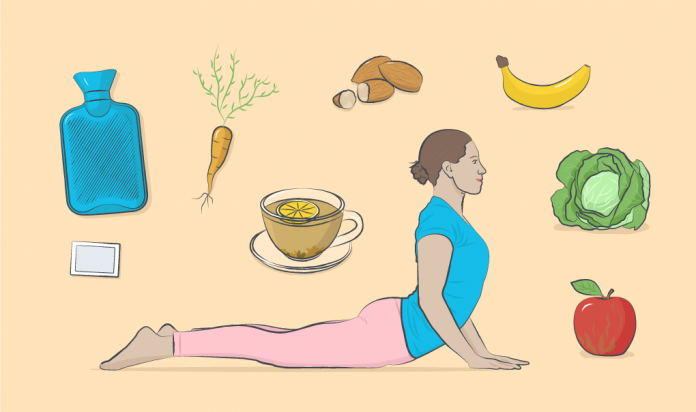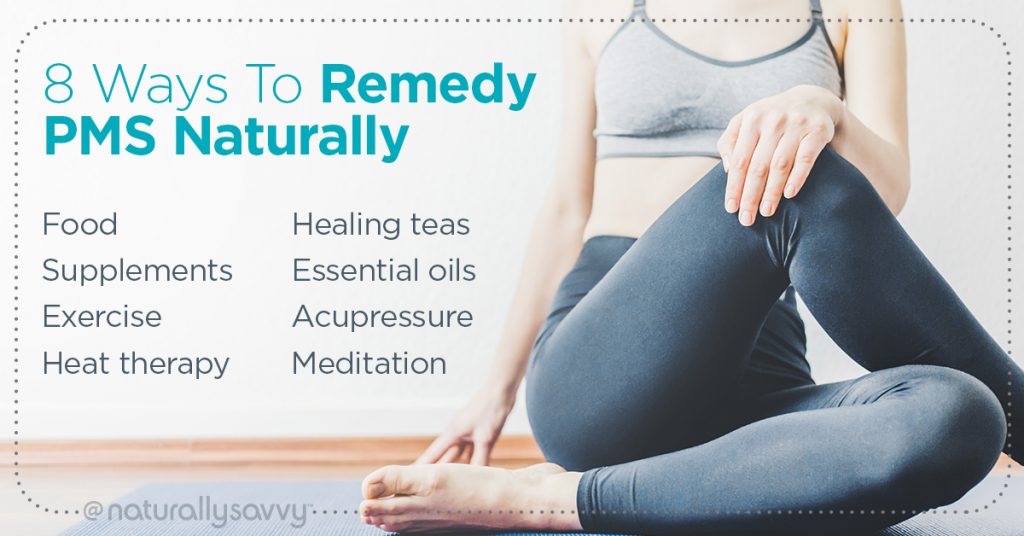
It’s our favorite time of the month again when the running list of premenstrual symptoms (PMS) comes knocking at the door to let you know your period is on its way. You may experience cramps, headaches, gassiness, mood swings, breast tenderness, and more. In short, PMS can be a real pain, and you may be looking for remedies to help.
Conventional methods of period pain relief may work for you. But if you are looking to treat PMS naturally and without over-the-counter medications, there are several steps you can take to work with your body’s menstrual cycle….
Foods to embrace
Food choices make a big difference in managing PMS symptoms. Focus on eating various fruits and vegetables, especially dark green leafy ones and others rich in antioxidants (think spinach, lettuce, kale, carrots, sweet potatoes, apples, and bananas). Bananas, for example, are a great source of potassium and vitamin B6, which can reduce bloating. Potassium is also necessary to help stop muscle cramping.
These foods can help fight fatigue and bloating. Unsalted, raw nuts are also a great addition because they provide inflammation-fighting omega-3 fatty acids. Complex carbs (think unprocessed oats, legumes, squash) can help stabilize your mood and control food/sugar cravings.
Foods to avoid
As a general recommendation, avoid processed and fast foods because they contain additives, salt, and/or added sugars that can contribute to PMS symptoms. Fresh food is best! Salt can be especially problematic if you are experiencing bloating, swollen hands, and tender breasts. Also, avoid or significantly limit the intake of alcohol and caffeine. Both can have a detrimental effect on sleep, energy levels, bloating, and gas.
Natural supplements
One of the first natural supplements to consider for PMS is magnesium. This mineral effectively relieves PMS symptoms, including anxiety, both alone and when taken with vitamin B6. Another mineral that improves PMS symptoms is zinc. One study, for example, reported that PMS symptoms decreased significantly among women who took zinc supplements, as this mineral can increase oxygen flow through the body.
Also consider B1 (thiamine), B6, and B12. Vitamin B1 can ease cramping, vitamin B6 helps produce happy hormones (i.e., dopamine and serotonin), and vitamin B12 can improve energy levels and pain.
Don’t forget calcium. Research shows that calcium supplements can reduce PMS symptoms by nearly half compared to placebo. Other research has shown that women with a high calcium intake from food sources had a significantly lower risk of PMS than those with a low intake.
On the herbal side, chaste tree berries (Vitex agnus-castus) may improve PMS symptoms. A recent systematic review found that the herb was effective and safe in treating PMS. It’s reported that chaste tree berries may reduce cramps, food cravings, breast pain, and swelling.
Exercise
Generally, movement helps ease cramps, improves blood flow, and can help with mood. Even if you don’t feel in the mood to exercise, regular aerobic activity can make you feel so much better because it releases endorphins and neurotransmitters (e.g., dopamine, serotonin) that improve energy, mood, and sleep. Change your exercise routines by walking, spinning, yoga, tai chi, swimming, or racket sports on PMS days.
Heat therapy
Two types of heat therapy can ease PMS symptoms, especially pelvic pain and cramping.
- Use a hot water bottle or heating pad placed on the abdominal area.
- Soaking in a warm tub with or without essential oils or Epsom salts (rich in magnesium). Add calming essential oils to the bath like lavender, clary sage, rose, and sandalwood. Use 5 to 10 drops in the tub. Epsom salts (magnesium) can help relieve cramping and pain. Use 1 ½ to 2 cups of Epsom salts and soak for at least 10 minutes.

Healing teas
Relaxing with a hot cup of healing tea one or more times a day can relieve pain. Three teas to consider:
- Chamomile contains antioxidants that may ease stomach and pelvic discomfort, help with mood swings, and reduce cramping.
- Dong Quai is a traditional Chinese tea that can ease uterine contractions and thus reduce menstrual cramps.
- Ginger, which can help with nausea or stomach distress.
Read about eight ways to calm down and decrease stress levels
Essential oils
Applying essential oils to your skin or inhaling their aroma can help ease PMS symptoms. Be sure to use a carrier oil (e.g., almond, coconut, jojoba) before massaging them into your skin. Here are four to consider:
- Clary sage: This oil is best known for reducing stress, cramping, and mood swings.
- Geranium: This oil reportedly can balance your mood. It also works great when combined with lavender and peppermint essential oils.
- Lavender oil: You can expect results similar to clary sage essential oil.
- Peppermint oil: If you are experiencing tummy upset and digestion problems, massage this oil before and after eating.
Acupressure
Once you learn a few acupressure points, you can help control your PMS symptoms anytime, anywhere. Pressure applied to specific points can increase the flow of chi (flow of life energy). Pictures are worth a thousand words, so check out some of the best acupressure points for relieving bloating, abdominal cramps, headaches, and more.
One easy point to explain is on your hand: Using your thumb and index finger, apply pressure to the fleshy joint between your thumb and index finger on your other hand. This can calm your uterine muscles and relieve headaches, abdominal pain, and constipation.
Meditation
Can you meditate your way away from PMS symptoms? Some studies say yes. In the journal Mindfulness, the authors noted that “mindfulness [meditation] is predictive of improved symptomatology.” Meditation can be especially helpful during PMS times because it can help you be calmer and sleep better, assist in resisting food cravings, and work to balance your moods better.
Bottom line
You don’t have to suffer every month or take conventional medications—there are ways to remedy PMS naturally. These natural techniques work best if you adopt two or more into your lifestyle. We bet you’ll be glad you did!
[Editor's Note: Another item to consider is choosing 100% Organic Cotton Period Products from Natracare. Choosing organic limits the burden and exposure to unnecessary chemicals through your vagina. Some conventional liners and other feminine hygiene products contain fragrance, a known endocrine disruptor that messes with your hormones. And when you are PMSing, who needs that.]
Read this next: How Does My Period Impact the Environment?
Sources
Bertone-Johnson ER et al. Calcium and vitamin D intake and risk of incident premenstrual syndrome. Archives of Internal Medicine 2005 Jun 13; 165(11): 1246-52
Boyle NB et al. The effects of magnesium supplementation on subjective anxiety and stress: a systematic review. Nutrients 2017 Apr 26; 9(5)
Cerqueira RO et al. Vitex agnus castus for premenstrual syndrome and premenstrual dysphoric disorder: a systematic review. Archives of Women’s Mental Health 2017 Dec; 20(6): 713-19
Eby GA. Zinc treatment prevents dysmenorrhea. Medical Hypotheses 2007; 69(2): 297-301
Edgar J. Herbal remedies for PMS. WebMD
Fathizadeh N et al. Evaluating the effect of magnesium and magnesium plus vitamin B6 supplement on the severity of premenstrual syndrome. Iranian Journal of Nursing and Midwifery Research 2010 Dec; 15 (Suppl 1): 401-5
Lustyk MKB et al. Relationships among premenstrual symptom reports, menstrual attitudes, and mindfulness. Mindfulness 2011 Mar; 2(1): 37-48
Mukherjee B. Top 9 acupressure points to treat premenstrual syndrome (PMS). Modern Reflexology
Orenstein BW. 8 foods that help fight PMS. Everyday Health 2013 Jan 2
Siahbazi S et al. Effect of zinc sulfate supplementation on premenstrual syndrome and health-related quality of life. Clinical randomized controlled trial. Journal of Obstetrics and Gynaecology Research 2017 May; 43(5): 887-894
Thys-Jacobs S et al. Calcium carbonate and the premenstrual syndrome: effects on premenstrual and menstrual symptoms. Premenstrual Syndrome Study Group. American Journal of Obstetrics & Gynecology 1998 Aug; 179(2): 444-52










